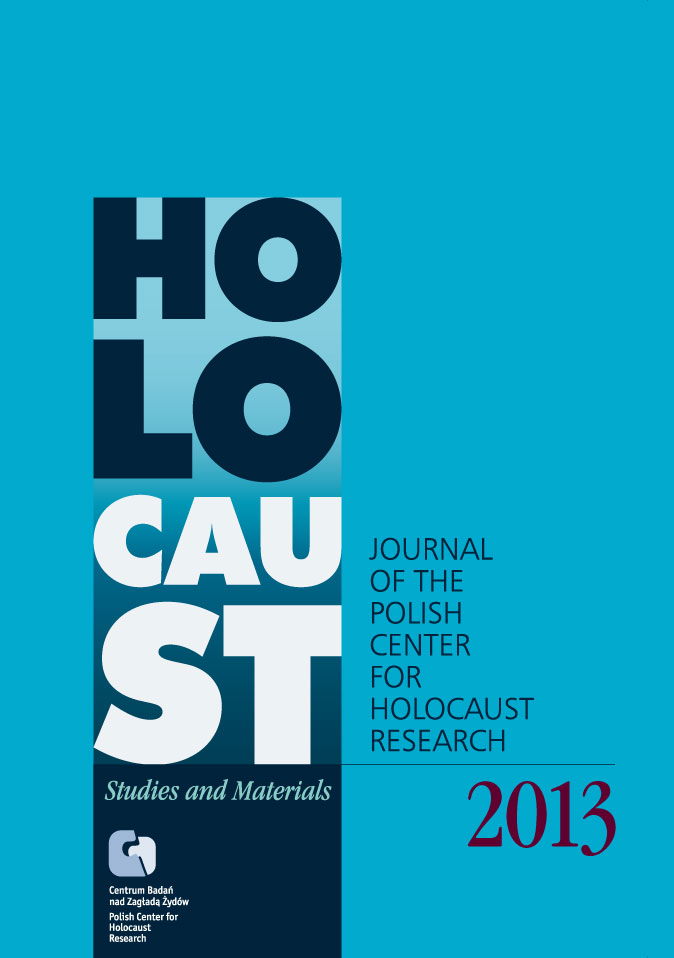Miriam Chaszczewacka’s Diary
Zagłada Żydów. Studia i Materiały, Nr Holocaust Studies and Materials (2013), Strony: 52`1-562
Data zgłoszenia: 2020-12-13Data publikacji: 2013-02-20
 https://doi.org/10.32927/zzsim.838
https://doi.org/10.32927/zzsim.838
Abstrakt
Diary of Miriam Chaszczewacka, a teenage resident of Radom. She wrote it since August 1939 – she started on the eve of the Third Reich’s attack on Poland – until the end of October 1942, when she was killed during the liquidation of the ghetto. Written in Polish, conceived as a letter to the future generations, Miriam’s diary shows the daily life in the ghetto and the extermination of its population based on the example of Radom. Her diary entries are mostly spontaneous notes of a young girl writing about her life. But she also describes the deteriorating conditions of the life in the ghetto and the general political situation. This
is a dramatic record of the increasing awareness of the inevitably approaching death.
Licencja
Prawa autorskie (c) 2013 Autor&"Zagłada Żydów. Studia i Materiały"

Utwór dostępny jest na licencji Creative Commons Uznanie autorstwa 4.0 Międzynarodowe.
https://creativecommons.org/licenses/by/4.0
Czasopismo publikowane jest w standardzie Diamond Open Access na licencji CC-BY-4.0 Deed - Uznanie autorstwa 4.0 Międzynarodowa - Creative Commons
Inne teksty tego samego autora
- Feliks Tych, Pamiętnik Miriam Chaszczewackiej , Zagłada Żydów. Studia i Materiały: Nr 9 (2013)
- Feliks Tych, Barbara Engelking, O ukrywaniu się po „aryjskiej stronie” z Feliksem Tychem rozmawia Barbara Engelking , Zagłada Żydów. Studia i Materiały: Nr 1 (2005)
- Feliks Tych, Pamięci dr Ruty Sakowskiej, badaczki Holokaustu , Zagłada Żydów. Studia i Materiały: Nr 7 (2011)
Podobne artykuły
- Anna Ziębińska-Witek, Kicz i Holokaust, czyli pedagogiczny wymiar ekspozycji muzealnych , Zagłada Żydów. Studia i Materiały: Nr 6 (2010)
- Karolina Panz, tłumaczenie dzienika B. Kalba z jidysz Monika Polit, tłumaczenie dziennika B. Kalba z jidysz - Ewa Kuma-Zielińska, „Na pamiątkę dla Pańskich synów i przyszłych pokoleń, by oddać cześć Pańskim czynom” – materiały do historii przemytnika Benziona Kalba , Zagłada Żydów. Studia i Materiały: Nr 18 (2022)
- Vincent A. Lapomarda, SJ, Papież Pius XII i Żydzi. Dlaczego powinien zostać beatyfikowany? , Zagłada Żydów. Studia i Materiały: Nr 5 (2009)
- Ján Hlavinka, Historiografia słowacka wobec problematyki Zagłady , Zagłada Żydów. Studia i Materiały: Nr 11 (2015)
- Jacek Leociak, Ginczanka , Zagłada Żydów. Studia i Materiały: Nr 11 (2015)
- Agnieszka Haska, Arnon Rubin, Facts and Fictions about the Rescue of the Polish Jewry during the Holocaust , Zagłada Żydów. Studia i Materiały: Nr 3 (2007)
- Marnix Croes, Zagłada Żydów w Holandii a odsetek ocalałych , Zagłada Żydów. Studia i Materiały: Nr 4 (2008)
- Aleksandra Ubertowska, The Comforting Power of Kitsch. The (Esthetic) Meanders of Holocaust Literature , Zagłada Żydów. Studia i Materiały: 2010: Holocaust Studies and Materials
- Witold Mędykowski, Przeciw swoim: Wzorce kolaboracji żydowskiej w Krakowie i okolicy , Zagłada Żydów. Studia i Materiały: Nr 2 (2006)
- Caroline Sturdy Colls, Gone but not Forgotten: Archaeological approaches to the site of the former Treblinka Extermination Camp in Poland , Zagłada Żydów. Studia i Materiały: Nr Holocaust Studies and Materials (2013)
<< < 10 11 12 13 14 15 16 17 18 19 20 21 22 23 24 25 26 27 28 29 30 31 32 33 34 35 36 37 38 39 40 41 42 43 44 45 46 47 48 49 50 51 52 53 54 55 56 57 58 59 > >>
Możesz również Rozpocznij zaawansowane wyszukiwanie podobieństw dla tego artykułu.
 English
English
 Język Polski
Język Polski




